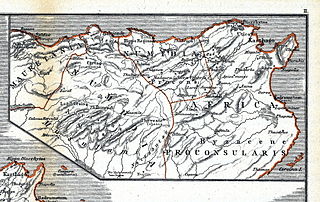Related Research Articles
Patriarchate, Archdiocese, Diocese, Territory, or Exarchate of Jerusalem may refer to:

The Exarchate of Africa was a division of the Byzantine Empire around Carthage that encompassed its possessions on the Western Mediterranean. Ruled by an exarch (viceroy), it was established by the Emperor Maurice in 591 and survived until the Muslim conquest of the Maghreb in the late 7th century. It was, along with the Exarchate of Ravenna, one of two exarchates established following the western reconquests under Emperor Justinian I to administer the territories more effectively.

Pisidia was a region of ancient Asia Minor located north of Pamphylia, northeast of Lycia, west of Isauria and Cilicia, and south of Phrygia, corresponding roughly to the modern-day province of Antalya in Turkey. Among Pisidia's settlements were Antioch in Pisidia, Termessos, Cremna, Sagalassos, Etenna, Neapolis, Selge, Tyriacum, Laodiceia Katakekaumene, Adada (Pisidia) and Philomelium.
The Laterculus Veronensis or Verona List is a list of Roman provinces and barbarian peoples from the time of the emperors Diocletian and Constantine I, most likely from AD 314.

The name early African church is given to the Christian communities inhabiting the region known politically as Roman Africa, and comprised geographically somewhat around the area of the Roman Diocese of Africa, namely: the Mediterranean littoral between Cyrenaica on the east and the river Ampsaga on the west; that part of it that faces the Atlantic Ocean being called Mauretania, in addition to Byzacena. Thus corresponding somewhat to contemporary Morocco, Algeria, Tunisia and Libya. The evangelization of Africa followed much the same lines as those traced by Roman civilization. From the late fifth and early sixth century, the region included several Christian Berber kingdoms.
Consularis is a Latin adjective indicating something pertaining to the position or rank of consul. In Ancient Rome it was also used as a noun to designate those senators who had held the office of consul or attained consular rank as a special honour. In Late Antiquity, the title became also a gubernatorial rank for provincial governors.

The Catholic Church in Tunisia is part of the worldwide Catholic Church, under the spiritual leadership of the Pope in Rome.

The Catholic Church in Turkey is part of the worldwide Catholic Church, under the spiritual leadership of the Pope and the canonical leadership of the curia in Rome that is submitted to the Pope.

The Catholic Church in Syria is part of the worldwide Catholic Church, under the spiritual leadership of the Pope in Rome.

The Diocese of Africa was a diocese of the later Roman Empire, incorporating the provinces of North Africa, except Mauretania Tingitana. Its seat was at Carthage, and it was subordinate to the Praetorian prefecture of Italy.
The Notitia provinciarum et civitatum Africae is a Byzantine-era document listing the bishops and sees in the Roman provinces of North Africa, Sardinia and the Balearics. The cause of its preparation was the council of Carthage held on 1 February 484 by the Arian king of the Vandals, Huneric (477–484).
This is a historical list of all bishops of the Catholic Church whose sees were within the present-day boundaries of the United States, with links to the bishops who consecrated them. It includes only members of the United States Conference of Catholic Bishops and their predecessors.
Catholic dioceses in the Holy Land and Cyprus is a multi-rite, international episcopate in Israel and Cyprus.

Numidia was a Roman province on the North African coast, comprising roughly the territory of north-east Algeria.
The gens Tannonia was an obscure plebeian family at ancient Rome. Few members of this gens are mentioned in Roman literature, but many are known from inscriptions.
The gens Titurnia was an obscure plebeian family at ancient Rome. Few members of this gens are mentioned in history, but others are known from inscriptions.
The Eastern Catholic Churches of the Catholic Church utilize liturgies originating in Eastern Christianity, distinguishing them from the majority of Catholic liturgies which are celebrated according to the Latin liturgical rites of the Latin Church. While some of these sui iuris churches use the same liturgical ritual families as other Eastern Catholic churches and Eastern churches not in full communion with Rome, each church retains the right to institute its own canonical norms, liturgical books, and practices for the ritual celebration of the Eucharist, other sacraments, and canonical hours.
References
- ↑ Annuario Pontificio 2013 (Libreria Editrice Vaticana 2013 ISBN 978-88-209-9070-1)
- ↑ Cf. Glossary of Catholic Terms, p. 7 Archived 2014-08-08 at the Wayback Machine